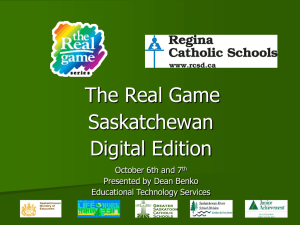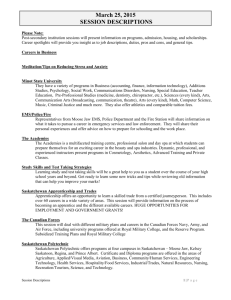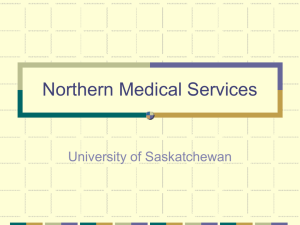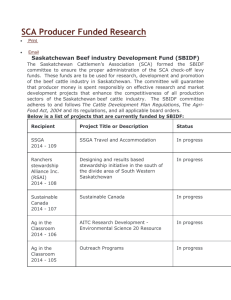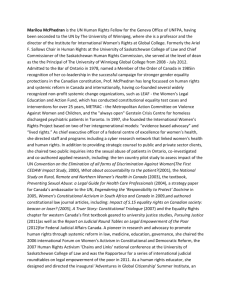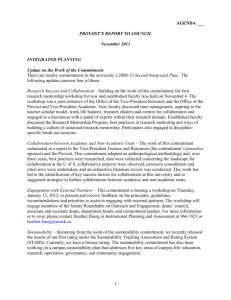Subject: Social Studies 4 Outcome: IN4.1 Analyze how First Nations
advertisement
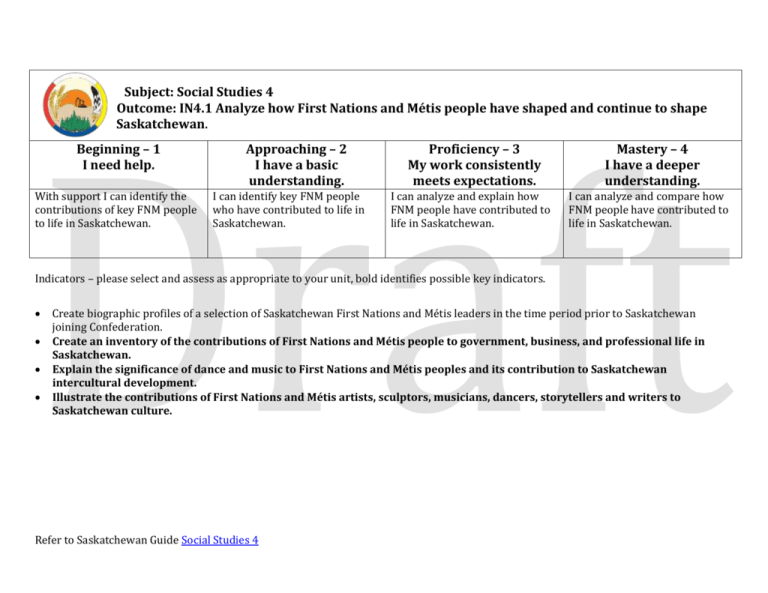
Subject: Social Studies 4 Outcome: IN4.1 Analyze how First Nations and Métis people have shaped and continue to shape Saskatchewan. Beginning – 1 I need help. With support I can identify the contributions of key FNM people to life in Saskatchewan. Approaching – 2 I have a basic understanding. I can identify key FNM people who have contributed to life in Saskatchewan. Proficiency – 3 My work consistently meets expectations. I can analyze and explain how FNM people have contributed to life in Saskatchewan. Mastery – 4 I have a deeper understanding. I can analyze and compare how FNM people have contributed to life in Saskatchewan. Indicators – please select and assess as appropriate to your unit, bold identifies possible key indicators. Create biographic profiles of a selection of Saskatchewan First Nations and Métis leaders in the time period prior to Saskatchewan joining Confederation. Create an inventory of the contributions of First Nations and Métis people to government, business, and professional life in Saskatchewan. Explain the significance of dance and music to First Nations and Métis peoples and its contribution to Saskatchewan intercultural development. Illustrate the contributions of First Nations and Métis artists, sculptors, musicians, dancers, storytellers and writers to Saskatchewan culture. Refer to Saskatchewan Guide Social Studies 4 Subject: Social Studies 4 Outcome: IN4.2 Describe the origins of the cultural diversity in Saskatchewan communities. Beginning – 1 I need help. Approaching – 2 I have a basic understanding. With assistance I can identify the different cultural groups who settled in Saskatchewan. I can identify the different cultural groups who have settled in Saskatchewan. Proficiency – 3 My work consistently meets expectations. I can describe the progression of human settlement prior to European contact to the present and provide reasons for their coming to Saskatchewan. Indicators – please select and assess as appropriate to your unit, bold identifies possible key indicators. Mastery – 4 I have a deeper understanding. I can describe and compare the progression of human settlement in Saskatchewan from prior to European contact to the present. Identify the traditional locations of the various First Nations tribes and language groupings in Saskatchewan prior to European contact. Detail the ways in which First Nations peoples supported the survival of early European newcomers to Saskatchewan. Trace and represent the history of European immigration to Saskatchewan including those who came for economic reasons and religious reasons. Articulate reasons why European immigrants left their homelands and settled in Saskatchewan, with particular emphasis upon the local community and/or the individual student families. Represent through speaking, writing, drama, multimedia, or other form, the challenges faced, both historically and in the current era, by First Nations people, Métis people, and immigrants to Saskatchewan. Identify strategies by which diverse cultural communities in Saskatchewan learned to work together for the common good. Compare immigration patterns in Saskatchewan in the 19th and early 20th centuries to immigration patterns in the current era. Identify the significance of historic buildings and places associated with cultural diversity in the community and province. Investigate the role of archaeology in understanding the origins of Saskatchewan communities. Refer to Saskatchewan Guide Social Studies 4 Subject: Social Studies 4 Outcome: IN4.3 Determine the influence Saskatchewan people and programs have had on a national scale. Beginning – 1 I need help. I can identify Saskatchewan people who have influenced Canada but need assistance to explain their impact. Approaching – 2 I have a basic understanding. I can identify Saskatchewan people and programs that have influenced Canada. Proficiency – 3 My work consistently meets expectations. I can describe the influence of Saskatchewan people and programs on Canada. Mastery – 4 I have a deeper understanding. I can identify and compare the influence of Saskatchewan people and programs on Canada. Indicators – please select and assess as appropriate to your unit, bold identifies possible key indicators. Identify the impact of programs originating in Saskatchewan on Canada and global communities. Represent the accomplishments of prominent Saskatchewan people whose contributions in their field are nationally or internationally recognized in a gallery, media clips, vignettes, or other media. Investigate the value of volunteerism in various local community organizations and activities. Refer to Saskatchewan Guide Social Studies 4 Subject: Social Studies 4 Outcome: DR4.1 Correlate the impact of the land on the lifestyles and settlement patterns of the people of Saskatchewan. Beginning – 1 I need help. I understand that different peoples settled in Saskatchewan and with support I can identify where they settled. Approaching – 2 I have a basic understanding. Proficiency – 3 My work consistently meets expectations. I understand why different peoples settled where they did in Saskatchewan. I can connect this to the geography of our province. I can identify where and why different peoples settled in Saskatchewan. I can identify how their traditions have been influenced by geography. Mastery – 4 I have a deeper understanding. I can compare the reasons the different cultural groups settled in Saskatchewan. Indicators – please select and assess as appropriate to your unit, bold identifies possible key indicators. Locate Saskatchewan on a map of Canada, North America, and the world. Locate the geographic centre of Saskatchewan on a map. Make inferences about why people in Saskatchewan settled particular locations, including settlement patterns before and after coming together of First Nations and European peoples using a variety of maps. Identify the characteristics of the unique geographic regions in Saskatchewan. Identify the impact of geography on the architecture of Saskatchewan, including how styles, materials, and cultural traditions have been affected by interaction with the land and other people in the province. Analyze the influence of geography on the lifestyle of people living in Saskatchewan. Conduct an inquiry investigating how residents of Saskatchewan came to occupy the land that is now our province. Refer to Saskatchewan Guide Social Studies 4 Subject: Social Studies Outcome: DR4.2 Explain the relationship of First Nations and Métis peoples with the land. Beginning – 1 I need help. I understand that prior to European contact FNM people had closer ties to the land and with assistance I can explain those changes. Approaching – 2 I have a basic understanding. I understand the relationship between the First Nations and Metis people with the land has change because of European contact. I recognize how the loss of land and use of reserves has impacted the people and their relationship with the land. Indicators – please select and assess as appropriate to your unit, bold identifies possible key indicators. I can explain how FNM people’s relationship with the land has changed since European contact. Proficiency – 3 My work consistently meets expectations. Mastery – 4 I have a deeper understanding. I can use my understanding of the historical process of the loss of land for Aboriginal people to see how this impacts on their future. Investigate the traditional worldviews of First Nations peoples prior to European contact regarding land as an animate object and sustaining life force. Research traditional lifestyles of First Nations communities and peoples prior to European contact. Explore how the traditional worldviews and teachings of First Nations’ Elders regarding land influence the lifestyle of First Nations people today. Research the history of the Métis people and their relationship with the land. Compare the traditional views of land and culture of the Aboriginal peoples of Saskatchewan with those of the railway developers. Assess the impact of historic loss of land on First Nations and Métis people. Investigate the process by which decisions were made about the location of reserve lands in Saskatchewan. Research the Métis struggle for land, and the displacement of Métis people in the late 19th century. Refer to Saskatchewan Guide Social Studies 4 Subject: Social Studies 4 Outcome: DR4.3 Analyze the implications of the Treaty relationship in Saskatchewan. Beginning – 1 I need help. I understand that treaties were signed in our province and with support I can explain how they benefit all people. Approaching – 2 I have a basic understanding. I understand that treaties were negotiated across Saskatchewan and that they benefit all people. Proficiency – 3 My work consistently meets expectations. I can explain the conditions under which the treaties were signed in Saskatchewan and the benefits for all people. Mastery – 4 I have a deeper understanding. I understand how the Treaty relationship benefits all people and how this will impact us in the future. Indicators – please select and assess as appropriate to your unit, bold identifies possible key indicators. Locate Treaty areas within Saskatchewan and locate reserves within the Treaty area of the school. Investigate conditions, which precipitated Treaty negotiations in Saskatchewan. Research Treaty provisions, including the spirit and intent of Treaties as well as material considerations. Assess the benefits of Treaties to all Saskatchewan people. Refer to Saskatchewan Guide Social Studies 4 Subject: Social Studies 4 Outcome: PA4.1 Analyze the relationship between governance institutions in Saskatchewan and the quality of life of people in the province. Beginning – 1 I need help. Approaching – 2 I have a basic understanding. Proficiency – 3 My work consistently meets expectations. Mastery – 4 I have a deeper understanding. With assistance I can identify the democratic processes used in Saskatchewan. I can state the democratic processes used in Saskatchewan and how they relate to the quality of life of our citizens. I can explain the democratic processes used in Saskatchewan and how they relate to the quality of life of our citizens. I can compare and contrast the democratic processes used in Saskatchewan and how they relate to the quality of life of our citizens. Indicators – please select and assess as appropriate to your unit, bold identifies possible key indicators. Identify ways in which Saskatchewan people can be involved in making decisions, which affect their local communities. Illustrate the organization of the municipal or band decision-making process, including the name of the sitting mayor, reeve, or chief. Describe ways in which Saskatchewan people can be involved in the democratic process regarding decisions, which affect their province, and explain why it is important to be an active participant in the democratic process. Represent the structure of the provincial decision-making process in Saskatchewan naming the sitting premier, the leader of the opposition, and the local member of the legislative assembly. Investigate the methods the provincial government uses to raise revenue. Analyze how the symbols of Saskatchewan, including the coat of arms, the flag, and the provincial motto, reflect the values and qualities of the people and the government of Saskatchewan. Refer to Saskatchewan Guide Social Studies 4 Subject: Social Studies 4 Outcome: PA4.2 Demonstrate an understanding of the provincial system of government. Beginning – 1 I need help. With assistance I can name the levels of government and responsibilities. Approaching – 2 I have a basic understanding. Proficiency – 3 My work consistently meets expectations. I can list the levels of government I can explain the three levels of and the general responsibilities. government and distinguish between the responsibilities of each. Mastery – 4 I have a deeper understanding. I can compare and contrast the three levels of government and the responsibilities of each. Indicators – please select and assess as appropriate to your unit, bold identifies possible key indicators. Differentiate between rules and laws. Differentiate between rights and responsibilities. Describe the relationship between three levels of government in Canada, including local (i.e., municipal, band), provincial or territorial, and federal. Identify elected local, provincial, and federal heads of government. Compare how laws are made at the local and provincial levels. Refer to Saskatchewan Guide Social Studies 4 Subject: Social Studies 4 Outcome: PA4.3 Demonstrate an understanding of the First Nations system of governance. Beginning – 1 I need help. With assistance I can identify the different levels of the First Nations system of governance. Approaching – 2 I have a basic understanding. I can list the different levels of the First Nations system of governance. Proficiency – 3 My work consistently meets expectations. I can explain the different levels of the First Nations system of governance. Mastery – 4 I have a deeper understanding. I can compare and contrast the different levels of the First Nations system of governance. Indicators – please select and assess as appropriate to your unit, bold identifies possible key indicators. Research the structures of governance in First Nations communities (e.g., local band council, tribal council, Federation of Saskatchewan Indian Nations, Assembly of First Nations). Compare the traditional processes for selection of leaders in First Nations communities to current practices for selection of leaders in First Nations. Compile an inventory of issues of current focus for First Nations governments in Saskatchewan. Refer to Saskatchewan Guide Social Studies 4 Subject: Social Studies 4 Outcome: PA4.4 Demonstrate an understanding of the Métis governance system. Beginning – 1 I need help. With assistance I can identify the different levels of the Métis system of governance. Approaching – 2 I have a basic understanding. I can list the different levels of the Métis system of governance. Proficiency – 3 My work consistently meets expectations. I can explain the different levels of the Métis system of governance. Mastery – 4 I have a deeper understanding. I can compare and contrast the different levels of the Métis system of governance. Indicators – please select and assess as appropriate to your unit, bold identifies possible key indicators. Research the structures of governance of Métis people in Saskatchewan. Compare the traditional processes for selection of leaders of Métis people to current practices for selection of leaders by the Métis people. Compile an inventory of issues of current focus for Métis governments in Saskatchewan. Refer to Saskatchewan Guide Social Studies 4 Subject: Social Studies 4 Outcome: RW4.1 Analyze the strategies Saskatchewan people have developed to meet the challenges presented by the natural environment. Beginning – 1 I need help. With assistance I can identify strategies used by people in Saskatchewan to meet the challenges of the natural environment. Approaching – 2 I have a basic understanding. I can identify strategies used by people in Saskatchewan to meet the challenges of the natural environment. Proficiency – 3 My work consistently meets expectations. I can analyze strategies used by people in Saskatchewan to meet the challenges of the natural environment. Mastery – 4 I have a deeper understanding. I can compare and contrast strategies used by people in Saskatchewan to meet the challenges of the natural environment. Indicators – please select and assess as appropriate to your unit, bold identifies possible key indicators. List the challenges and opportunities climate presents for residents of Saskatchewan. Determine safety measures necessary for living in the Saskatchewan climate. Retell the stories of Elders, traditional knowledge keepers, and senior citizens about surviving weather extremes. Collect the natural weather forecasting techniques of Elders, traditional knowledge keepers, senior citizens, and others with local knowledge. Represent the traditions and practices Saskatchewan people developed when faced with isolation, including First Nations practices adopted by Europeans. Research past and present technologies used to withstand the Saskatchewan climate. Investigate the technological evolution of farming practices in Saskatchewan, including crop variety development, pesticide and herbicide use, and soil and water conservation. Graph the typical energy consumption in Saskatchewan for an average year, and investigate energy efficient technologies being developed in Saskatchewan. Refer to Saskatchewan Guide Social Studies 4 Subject: Social Studies 4 Outcome: RW4.2 Investigate the importance of agriculture to the economy and culture of Saskatchewan. Beginning – 1 I need help. Approaching – 2 I have a basic understanding. With assistance I can list types of agriculture. I can list types of agriculture and have a general understanding of its importance to the economy and culture of Saskatchewan. Proficiency – 3 My work consistently meets expectations. I can explain the importance of agriculture to the economy and culture of Saskatchewan. Mastery – 4 I have a deeper understanding. I can compare and contrast they types agriculture and how they impact the economy and culture of Saskatchewan. Indicators – please select and assess as appropriate to your unit, bold identifies possible key indicators. Identify and locate various types of farms in Saskatchewan. Research production practices of various types of crop and livestock farms. Identify various farm stewardship practices. Compile an inventory of Saskatchewan agricultural food and by-products. Identify agricultural products used in daily life in Saskatchewan. Trace the steps of a food product from the farm to the plates of consumers, and identify the various careers that contribute to this process in the agriculture and food processing industries. Analyze the significance of Saskatchewan agricultural commodity exports to the province. Refer to Saskatchewan Guide Social Studies 4 Subject: Social Studies 4 Outcome: RW4.3 Assess the impact of Saskatchewan resources and technological innovations on the provincial, national, and global communities. Beginning – 1 I need help. With assistance I can list resources and technological innovations in Saskatchewan. Approaching – 2 I have a basic understanding. I can list resources and technological innovations in Saskatchewan. Proficiency – 3 My work consistently meets expectations. Mastery – 4 I have a deeper understanding. I can assess the impact of Saskatchewan resources and technological innovations on the provincial, national, and global communities. I can compare and contrast the impacts of Saskatchewan resources and technological innovations on the provincial, national, and global communities. Indicators – please select and assess as appropriate to your unit, bold identifies possible key indicators. Represent on a map the major resources in Saskatchewan. Locate on a map the major industries in Saskatchewan. Differentiate between primary and secondary industry. Examine the environmental impact of the development of natural resources on the local community, the province, and the world. Describe the impact of technological innovations originating in Saskatchewan on the global community. Refer to Saskatchewan Guide Social Studies 4

